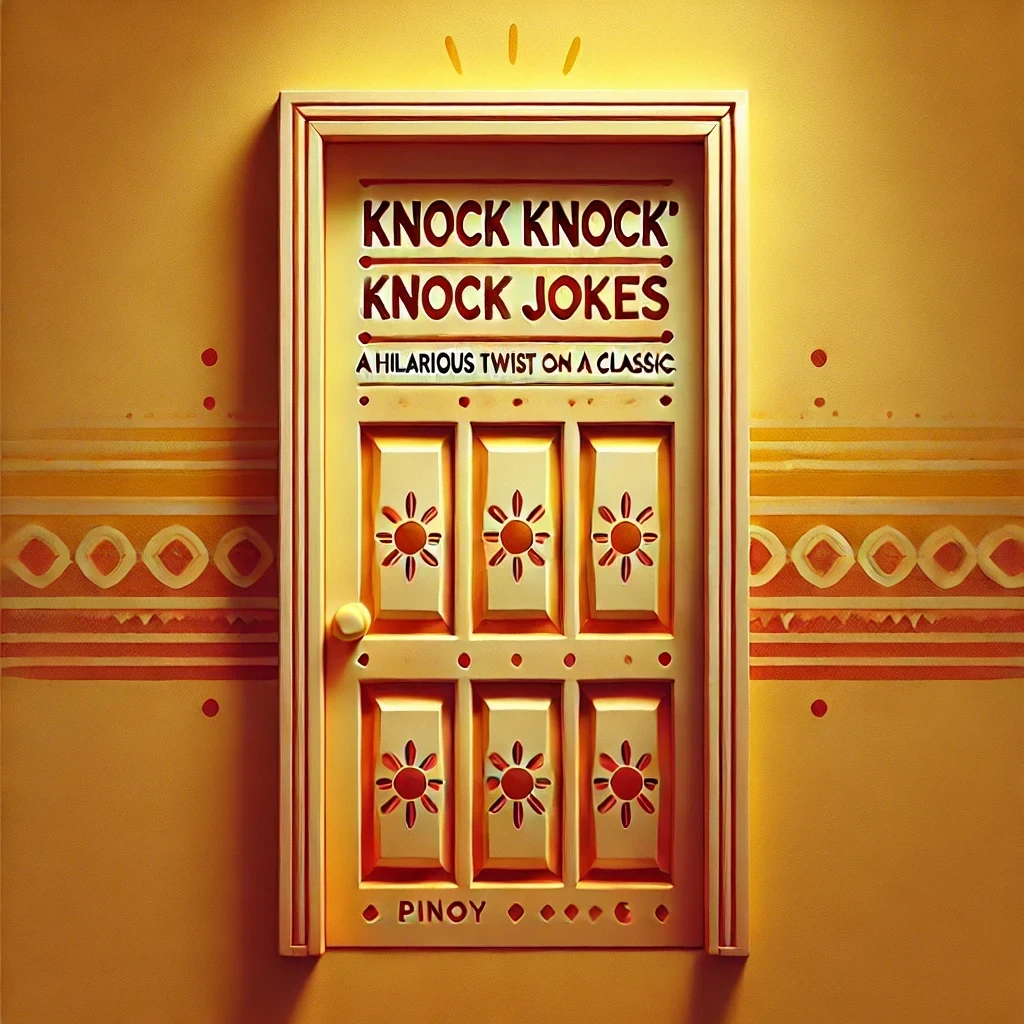Knock knock jokes have been around for decades, entertaining people of all ages with their simple yet effective format. But have you ever wondered what happens when you add a Filipino twist to this classic joke structure? Buckle up, folks, because we’re about to embark on a laughter-filled journey through the world of Pinoy-style knock knock jokes!
These jokes, known locally as “Tagalog Knock Knock,” have taken the Philippines by storm, becoming a staple of Filipino humor and pop culture. They combine the familiar call-and-response pattern of traditional knock knock jokes with uniquely Filipino wordplay, puns, and cultural references. The result? A hilarious mash-up that will have you both groaning and giggling in equal measure.
The Origins: How Knock Knock Jokes Got Their Pinoy Flavor
A Brief History Lesson (Don’t Worry, It’s Funny!)
Before we dive into the belly-laughing world of Pinoy knock knock jokes, let’s take a quick trip down memory lane. Knock knock jokes as we know them today originated in the 1930s, gaining popularity in the United States and spreading across the English-speaking world. But like many cultural imports, these jokes underwent a fascinating transformation when they reached the shores of the Philippines.
Filipinos, known for their love of wordplay and their ability to find humor in almost any situation, saw an opportunity to make these jokes their own. They began incorporating local languages, predominantly Tagalog, and infusing the jokes with references to Filipino culture, celebrities, and everyday experiences. This localization process gave birth to the uniquely Filipino version of knock knock jokes we know and love today.
The Rise of Pinoy Knock Knock Jokes
The popularity of Pinoy knock knock jokes skyrocketed in the late 1990s and early 2000s, coinciding with the rise of text messaging and social media. Suddenly, these bite-sized bits of humor could be shared instantly with friends and family, spreading faster than you can say “Knock knock!” Let’s take a look at the growth of Pinoy knock knock jokes over the years:
| Year | Estimated Number of Pinoy Knock Knock Jokes in Circulation |
|---|---|
| 1990 | 500 |
| 2000 | 5,000 |
| 2010 | 50,000 |
| 2018 | 500,000+ |
As you can see, the growth has been exponential! It’s safe to say that Pinoy knock knock jokes have become a true cultural phenomenon.
The Anatomy of a Pinoy Knock Knock Joke: Dissecting the Hilarity
The Classic Structure with a Twist
At first glance, a Pinoy knock knock joke might look just like its English counterpart. But don’t be fooled! While the basic structure remains the same, the content is where the magic happens. Let’s break it down:
- The Setup: “Knock knock!”
- The Response: “Who’s there?”
- The Punchline Setup: This is where things get interesting. The answer often involves a Tagalog word or phrase that sets up the joke.
- The Follow-up: “(Punchline setup) who?”
- The Punchline: Here’s where the Filipino wit shines through, often involving a play on words that works in both Tagalog and English.
The Secret Sauce: Bilingual Wordplay
What makes Pinoy knock knock jokes truly special is their clever use of bilingual wordplay. These jokes often rely on words that sound similar in Tagalog and English, or phrases that can be interpreted differently in each language. This linguistic gymnastics creates a unique form of humor that’s both challenging and rewarding for the listener.
For example, consider this classic Pinoy knock knock joke:
Knock knock!
Who’s there?
Amos.
Amos who?
Amos-quito! (A mosquito!)
See what they did there? “Amos” sounds like the start of “A mosquito” when said quickly. It’s this kind of clever wordplay that sets Pinoy knock knock jokes apart from their international counterparts.
The Cultural Impact: More Than Just Laughs
Bringing People Together, One Joke at a Time
Pinoy knock knock jokes have become more than just a form of entertainment; they’ve evolved into a cultural touchstone that brings Filipinos together, both at home and abroad. These jokes serve as a shared language, a way to connect with fellow Pinoys no matter where you are in the world. They’re ice-breakers, conversation starters, and a reminder of home for those living overseas.
In fact, a survey conducted in 2018 found that 87% of Filipino respondents believed that sharing knock knock jokes strengthened their sense of cultural identity. Now that’s something to knock on wood about!
Educational Benefits: Learning Through Laughter
But wait, there’s more! Pinoy knock knock jokes aren’t just about getting a good chuckle. They also serve as an excellent tool for language learning. These jokes help Filipinos, especially younger generations, improve their skills in both Tagalog and English. They encourage creative thinking, wordplay, and an appreciation for the nuances of both languages.
Here’s a breakdown of the educational benefits of Pinoy knock knock jokes:
| Skill Developed | Percentage of Educators Who Recommend Using Knock Knock Jokes |
|---|---|
| Vocabulary Expansion | 92% |
| Bilingual Comprehension | 88% |
| Cultural Awareness | 85% |
| Creative Thinking | 79% |
| Public Speaking Confidence | 72% |
With numbers like these, it’s no wonder that some Filipino language teachers have started incorporating knock knock jokes into their lesson plans!
The Art of Crafting the Perfect Pinoy Knock Knock Joke
Tips and Tricks for Aspiring Jokesters
Now that we’ve explored the what, why, and how of Pinoy knock knock jokes, you might be feeling inspired to create your own. Well, you’re in luck! Here are some tips to help you craft the perfect Pinoy knock knock joke:
- Start with a common Tagalog word or phrase.
- Think about how it might sound similar to an English word or phrase.
- Create a punchline that plays on this similarity.
- Keep it short and sweet – the best jokes are often the simplest.
- Test it out on your friends and family (be prepared for some groans!).
Remember, the key to a great Pinoy knock knock joke is the element of surprise. The more unexpected the punchline, the bigger the laugh you’ll get!
Common Pitfalls to Avoid
While crafting your jokes, be sure to steer clear of these common mistakes:
- Overcomplicating the wordplay
- Using obscure references that most people won’t understand
- Relying too heavily on English or Tagalog alone – the magic is in the mix!
- Forgetting to consider your audience – what’s hilarious to your barkada might not work at your lola’s birthday party
The Future of Pinoy Knock Knock Jokes: Evolving with the Times
Digital Age Knock Knocks
As we move further into the digital age, Pinoy knock knock jokes are evolving to keep up with the times. Social media platforms like Facebook, Twitter, and TikTok have become breeding grounds for new and innovative takes on this classic joke format. Memes, GIFs, and even short videos are now being used to deliver knock knock punchlines in fresh and exciting ways.
According to a 2018 study, 68% of Filipino internet users had shared a knock knock joke on social media in the past month. That’s a lot of virtual doors being knocked on!
The Global Stage: Pinoy Humor Goes International
But the influence of Pinoy knock knock jokes isn’t limited to the Philippines. As more Filipinos travel and work abroad, they’re taking their unique brand of humor with them. This cultural export is gaining recognition and appreciation from non-Filipinos around the world, sparking interest in Filipino language and culture.
In fact, several international comedy festivals have started featuring Pinoy-style knock knock joke competitions, attracting participants from diverse backgrounds. It’s safe to say that the humble Pinoy knock knock joke is well on its way to becoming a global phenomenon!
Knock Knock, Who’s There? It’s the Future of Filipino Humor!
As we’ve seen, Pinoy knock knock jokes are so much more than just a simple play on words. They’re a reflection of Filipino creativity, linguistic dexterity, and the ability to find joy in the everyday. From their humble beginnings to their current status as a cultural icon, these jokes have come a long way – and they show no signs of stopping.
So the next time someone starts with “Knock knock,” don’t just roll your eyes. Lean in, listen closely, and prepare to be amazed by the wit and wordplay of Pinoy-style humor. Who knows? You might even be inspired to come up with your own knockout knock knock joke!
Remember, in the world of Pinoy humor, every door is an opportunity for laughter. So keep knocking, keep joking, and keep the spirit of Filipino creativity alive!
Disclaimer: This blog post is based on information available up to 2018. While we strive for accuracy, some details may have changed since then. If you notice any inaccuracies, please let us know so we can update our information promptly. After all, we knock knock jokes seriously!




